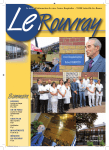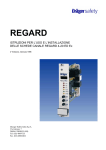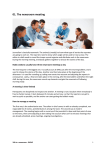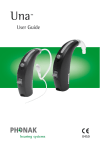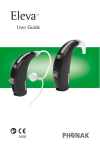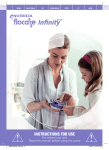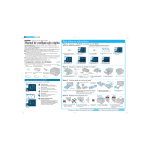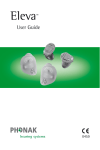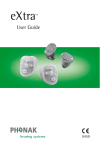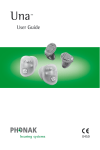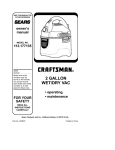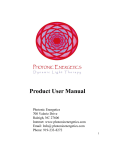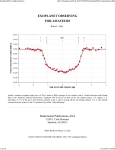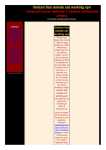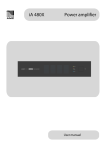Download PH`lNAK PH5>NAK - The Hearing Aid Museum
Transcript
PH'lNAK PH5>NAK hearing systems hearing systems Better Hearing ls For You N2:? us 4100 Brou ght to you by you r hearing hea Il hca re profession aI and Phona k How to Wear Your Hearing Instruments Hearing instruments are masterpieces of miniaturized electronics, complete with computerized microchips, mUlti-purpose switches and powerful amplifiers. Getting Acquainted With Your Hearing Instruments Getting the Most Out of Your Hearing Instruments Safety Issues Within the hearing instrument, a microphone acts as an artificial ear to "hear" sounds which the human ear may no longer be able to hear. After careful filtering and electronic processing, the sound is amplified, routed through a receiver (speaker) and directed into the ear canal. Serial Numbers Batteries Protect Your Hearing Instruments Troubleshooting FM Communication Systems Using the Telephone Two Ears Are Better Than One Please Note See the instruction manual for your own hearing instruments for an explanation of its parts and how they work. How to Wear Your Hearing lnstruments How to Wear Your Hearing lnstruments In-The-Ear CITE) Models Behind-The-Ear (BTE) Models Grasp the hearing in strument between your thumb and forefinger as shown. Keeping it in th is position, bring your hand up to your ear. To insert and remove the earmold on a BTE hearing instrument, follow the instructions for ITE units. Carefully insert the canal portion into the ear. Then, gently twist the top of the instrument into place along the inside curve of the ear (if applicable). Once in place, gently push on the instrument to be sure it is seated in your ear. When properl y seated, your hearing instrument should feel comfortable and secure. 2 Inserting your ITE hearing instrument. To remove the in strument, grasp with thumb and forefinger and gently pull out and up so the canal portion comes out fi rst. Ne ver pull the instrument out using the battery door or volume control- this could damage these components. Properly seated BTE. You must also ensure that the BTE fits comfortably over and behind the ear, as shown. Because putting in hearing instruments can be tricky at first, you should practice with your hearing healthcare professional. Properly inserted ITE. It takes time to get used to using hearing instruments. Be patient and give yourself a few days to learn how to handle them comfortably. 3 - Getting Acquainted with Your Hearing lnstruments When you first put on your hearing instruments, the world may suddenly seem noisy and alive with more sounds than you remember. This is because your hearing has not been functioning normally for some time, and as a result, everyday sounds which are now amplified by your hearing instruments may seem unnatura l to you. If you have worn hearing instruments before, the new ones will undoubtedly sound different. :;.- Getting the Most Out of Your Hearing lnstruments Concentrate on the people or sounds you want to hear. It takes work to focus your attention, but it makes a big difference. Structure the listening situation to your advantage. ~ Make sure that people have your attention before they speak. Some people prefer to "jump in" to hearing aid use by wearing them all the time, right from the beginning. Others prefer a more gradual approach, increasing wearing time by an hour each day. If you have worn hearing aids before, it is best to change to the new set all at once. Please discuss these methods with your hearing healthcare professional to see which is best for you . ~ Sit or stand closer to the source of what you want to hear, especially in a group situation where there is background noise. ~ If you join in a discussion, make sure yo u know the topic of conversation . It will help you to follow things better. ~ Practice "speech reading." Always watch the person speaking, and take your cues from facial expressions and gestures, as well as from lip and mouth movements. 4 5 Getting the Most Out of Your Hearing lnstnlments ~ Try to position yourself with the light source behind yo u That way the person you are listening to will be eas ier to see, rather than in a shadow. ~ In restaurants, request a booth instead of a table . If you do not have a directional or AudioZoom™ system, try to sit with your back to a wall so there is less noise behind you. ~ When possible, let people know what they can do to make it easier for you to hear. If specific situations are particularly bothersome, contact your hearing healthcare professional for advice on communication strategies or sp ecial assistive listening devices. Hearing instrument batteries can be dangerous if swallowed. If hearing instrument batteries are swallowed, seek immediate medical attention and call the National Button Battery Hotline collect at (202) 625-3333. Keep hearing instruments and batteries out of the reach of children and pets. Dogs are particularly attracted to the smell and may be tempted to chew on or destroy hearing instruments. If a pet swallows a battery, contact your veterinarian immediately. Never change the battery or adjust the controls of you r hearing instrument in front of infants, small children or developmentally- de laye d persons. Discard batteries where they cannot be reached. Note: Many Phonak hearing instruments can be equipped with tamper resistant battery compartments upon request. Consult your hearing healthcare professional for more information. Never allow others to wearyour hearing instruments. Hearing instruments are medical devices and are required by law to be fitted by a licensed hearing healthcare professional. 6 7 Batteries Serial Numbers Location of Phonak BTE and ITE Instrument Serial Numbers Serial numbers ind icating year of manufacture are clearly printed in the areas shown here, with the following formats: D3@ 12345 Year manufactured -@ 1234 [ Year manufacture Week manufactured 8 -.J When your hearing instruments begin to perform intermittently or stop working, usually it is time to change the batteries. To replace a battery, open the battery compartment, remove the battery and discard it immediately (see the warnings listed under "Safety Issues") . Insert a new battery so the "+" sign on the battery faces in the same direction as the "+" sign on the battery compartment. Your hearing healthcare professional will tell you the specific battery size you need. Battery life is dependent upon the type of hearing instrument, its settings and how it is used. Consult your hearing healthcare professional for informa tion on how long batteries can be expected to last in your instruments. Inserting batteries: in an ITE (left) and in a BTE (right). 9 Protect Your Hearing Instruments , Hair Spray/Face Creams Your hearing instrument is a sophisticated electronic device, designed to help you hear better. To ensure that you obtain the most from your instrument, you need to become a partner in protecting it from effects that might damage or degrade its performance. The following describes the things that you can do to ensure maximized performance. 1 Protect your instruments from: Ear Wax Keep your ears clean and dry. If necessary, have your ears cleaned regularly by a qualified healthcare professional. Dirt ond Debris Avoid adjustments to your volume control when your hands are dirty or wet. Perspiration Moisture 10 and Oils Do not wear your instruments during application of hair spray, face creams or make-up. Dropped/Physically Jarred Insert or remove them over a soft surface (towel, pillow, etc). Excessive Direct Heat Never dry your instruments with a blow dryer. Store away from direct sunlight or heating vents. Do not leave them in a hot car. Electromagnetic Procedures (Such as CAT or MRI Scans) Remove your hearing instruments during the procedure. Battery Leakage Store your instruments in a dehumidifier (available from your hearing healthcare professional) when not in use. Ensure that your ears are dry before inserting your hearing instruments. Store your hearing instruments outside of the bathroom during bathing or showering. Protect Your Hearing lnstruments , , Remove battery if you store your hearing instru ment for any length oftime. Care and Cleaning: Do not attempt to repair your hearing instrument yourself. Never stick anything other than the provided cleaning tool into the small openings on your hearing instruments. See your hearing instrument manual for specific information regarding care and cleaning. 11 Troubleshooting No Sound Short Battery Life ~ Be sure the on/off switch is ON. ~ ~ Lea vi ng the battery in the hearing instruments ove rnight while they are in the "ON" position may shorten battery life. Turn up the volume. ~ Check the function switch. On a BTE instrument, the setting should read 'M' or 'MT', or '0' if using a remote control. ~ Batteries can "short out" if they touch other batteries or metal objects. ~ Always use fresh batteries. ~ Check the battery. If your hearing instruments stop or work only intermittently, replace the batteries (see page on "Batteries"). ~ Discuss expected battery life with your hearing healthcare professional. ~ Make sure you ha ve the correct battery. ~ Sometimes, eve n new batteries may be defective, so try one from a different package. The vast majority of hearing aid malfunctions are caused by moisture and/or earwax damaging the components. Take care to keep your hearing aids clean and dry. Your hearing healthcare professiona l can advise you about proper care, maintenance and use of hearing aid drying systems. ~ Check tha t the battery is clean (rub both sides with a pencil eraser). Moisture and Ear Wax 12 13 Feedback (Whistling or Ringing) Feedback occurs when sound leaks out of your ear and is directed back into the hearing instrument's microphone. Make sure the earmold or ITE instrument is correctly seated in your ear. If yo u still experience feedb ack, the fit of the earmold or ITE may be too loose. Co nsu It yo urhea ri ng hea Ithca re professiona I. Hearing aid wearers sometimes have communication needs that go beyond what con ventional, programmable or even digital devices can offer. Factors such as background noise, reverberation and distance from the person you are trying to hear can degrade the signal, making it difficult to understa nd. That's why Phonak developed an innovative, wireless personal FM Communication System. Now you have an option for better hearing in a variety of situations. Sometimes earwax buildup in the ear canal can cause feedback. For this condition, consult your hearing healthcare professional. Remember, feedback wil l happen naturally whenever you cup your hand over your hearing instruments or remove the hearing instruments while they are still switched on. The Phonak MicroLink™ FM system consists of two parts: a transmitter that picks up the speaker's voice, and a receiver which delivers the speaker's voice directly to the listener's ear. Other Problems Check the earmold, tubing or ITE receiver tube to be sure they are not plugged with wax or moisture. Always keep your ear canal clean and free of moisture and wax. If you are troubled with excessive ear wax, see your hearing healthcare professional. Simply attach MicroLink to your Phonak BTE hearing aid. Place the FM transmitter close to voicers) or sound source you want to hear, and you will be able to hear even when you're at a distance. MicroLink':I. Personal FM System MicroLink is a discreet. easy to use and completely wireless solution for your hearing needs. Contact your hearing healthcare professional for more deta ils about FM systems. 14 15 Using the Telephone Two Ears Are Better Than One Most BTEs and many ITEs are equipped with a built-in telecoil that eliminates feedback by turning off the microphone, allowing you to listen on the telephone. To use the telecoil, switch to the "T" position. Usually, hearing loss is present in both ears. In this situation, two hearing aids are recommended - one in each ear. This is called "binaural hearing': Binaural hearing instruments may help you: For BTEs: Hold the earpiece of the phone over the hearing instrument, not against the eormold. The strength of the signal will vary depending upon the position of the phone. Most ITE models con be used with a phone by holding the receiver two or three inches from your ear. It also may help to tilt the receiver slightly. If feedback occurs, move the phone a little further away from your ear. Localize Sound Better You can hear an approaching car with just one hearing instrument. But two equally functioning ears will immediately tell you from which direction the car is coming. Understand More in Difficult Listening Situations Hearing with two ears improves your ability to discern wanted from unwanted sounds. Note: While most phones designed for home and business use are hearing aid compatible, cellular phones may be incompatible with hearing instruments. Hear Better with Less Binaural hearing typically means you can set the volume control lower than if you used only one instrument. If you have a problem using your telephone while wearing your hearing instrument, check with your hearing healthcare professional. 16 17 Please Note Hearing aids will not restore normal hearing and will not prevent or improve impairment resulting from organic conditions. Infrequent use of hearing aids does not allow the user to obtain full benefit from them . Remember, hearing only one part of hearing rehabilitation and may need to be supplemented by training and instruction in lip/speech reading . a hearing usually aids are auditory Warning to Hearing Aid Dispensers A hearing aid dispenser should advi se a prospect ive hearing aid user to consult promptl y with a licensed physician (preferably an ear speciali st) before dispensing hearing aids if the hearing aid dispenser determines through inquiry, actual observation or review of any other available information concerning the prospecti ve user, that the prospective user has any of the following conditions : ~ Visible congenital or traumatic deformity of the ear. ~ History of active drainage from the ear within the previous 90 days. ~ History of sudden or rapidl y progressing hearing loss within the previous 90 days. ~ Acute or chronic dizziness. ~ Unilateral hearing loss of sudden or recent onset within the previous 90 days. 18 Audiometric air-bone gap equal to or greater than 15dB at 500,1000 and 2000 Hz. Visible evidence of significant cerumen accumulation or a foreign body in the ear canal. Pain or discomfort in the ear. Special care should be exercised when selecting and fitting a hearing aid whose maximum SPL exceeds 132dB because there may be a risk of impairing the remaining hearing of the user. Important Notice for Prospective Hearing Aid Users Good health practice requires that a person with a hearing loss have a medical evaluation by a licensed physician (preferable one who specializes in diseases of the ear) before purchasing hearing aids. Licensed physicians who specialize in diseases of the ear are often referred to as otolaryngologists, otologists or otorhinolaryngologists. The purpose of the medical evalu ation is to assure that all medically treatable conditions that may affect hearing are identified and treated before the hearing aids are purchased. Following the medical evaluation, the physician will give you a written statement indicating that your hearing loss has been medically evaluated and that you may be considered a candidate for hearing aids. The physician will refer you to an audiologist or hearing aid dispenser as appropriate for a hearing aid evaluation. 19 Please Note The audiologist or hearing aid dispen ser will conduct a hearing aid evaluation to assess your ability to hear with and without a hearing aid. The hearing aid evaluation will enable the audiologist or dispen ser to select and fit a hearing aid for your individual needs. If you ha ve reservations about your ability to adapt to amplification, you should inquire about the availability of a trial-rental or purchase-option program. Many hearing aid dispensers now offer programs for a nominal fee that permit you to wear hearing aids for a period of time after which you ma y decide if you want to purchase the aid. Federal law restricts the sale of hearing aids to those individuals who have obtained a medical evaluation from a licensed physician. Federal law permits a full y informed adult to sign a waiver statement declining the medical evaluation if religious or personal beliefs preclude consultation with a physician. The exercise of such a wai ver is not in your best health interest and its use is strongly discouraged . 20 Children With Hearing Loss In addition to seeing a physician for a medical evaluation, a child with a hearing loss should be directed to an audiologist for evaluation and rehabilitation because hearing loss may cause problems with language development and the educational and social growth of the child . An audiologist is qualified by training and experience to assist in the evaluation and rehabilitation of a child with a hearing loss. Repair Service Repair service on your hearing aids can be obtained through your hearing healthcare professional. It is in your best interest to obtain service from a local hearing healthcare professional . If you do not have a hearing heathcare professional, Phonak can refer you to a professional in your area. For a referral, please contact: Phonak, Inc. 4520 Weaver Parkway Warrenville, IL 60555 1-800-679-4871 21












